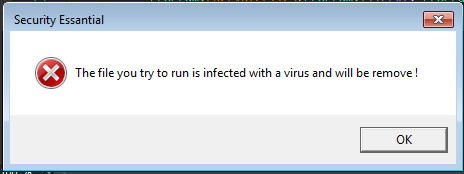RANSOM_PSHCRYPT.A
Windows


Threat Type: Ransomware
Destructiveness: No
Encrypted: No
In the wild: Yes
OVERVIEW
This Ransomware arrives on a system as a file dropped by other malware or as a file downloaded unknowingly by users when visiting malicious sites.
It deletes itself after execution.
TECHNICAL DETAILS
Arrival Details
This Ransomware arrives on a system as a file dropped by other malware or as a file downloaded unknowingly by users when visiting malicious sites.
Installation
This Ransomware drops the following copies of itself into the affected system:
- C:\ProgramData\xexplorer.exe
- %User Temp%\explorer.exe
(Note: %User Temp% is the user's temporary folder, where it usually is C:\Documents and Settings\{user name}\Local Settings\Temp on Windows 2000, Windows Server 2003, and Windows XP (32- and 64-bit); C:\Users\{user name}\AppData\Local\Temp on Windows Vista (32- and 64-bit), Windows 7 (32- and 64-bit), Windows 8 (32- and 64-bit), Windows 8.1 (32- and 64-bit), Windows Server 2008, and Windows Server 2012.)
It drops the following files:
- C:\ProgramData\DECRYPT YOUR FILE.key
- %User Temp%\MS-PRO.log ← List of encrypted files
(Note: %User Temp% is the user's temporary folder, where it usually is C:\Documents and Settings\{user name}\Local Settings\Temp on Windows 2000, Windows Server 2003, and Windows XP (32- and 64-bit); C:\Users\{user name}\AppData\Local\Temp on Windows Vista (32- and 64-bit), Windows 7 (32- and 64-bit), Windows 8 (32- and 64-bit), Windows 8.1 (32- and 64-bit), Windows Server 2008, and Windows Server 2012.)
Other System Modifications
This Ransomware adds the following registry entries:
HKEY_LOCAL_MACHINE\SOFTWARE\Microsoft\
Windows NT\CurrentVersion\Image File Execution Options\
userinit.exe
debugger = C:\ProgramData\xexplorer.exe
HKEY_LOCAL_MACHINE\SOFTWARE\Microsoft\
Windows\CurrentVersion\Policies\
System
EnableLUA = 0
HKEY_LOCAL_MACHINE\SOFTWARE\WCrypte
sKey = {Key}
HKEY_LOCAL_MACHINE\SOFTWARE\Microsoft\
Windows\CurrentVersion\Policies\
System
legalnoticecaption = "Warning"
HKEY_LOCAL_MACHINE\SOFTWARE\Microsoft\
Windows\CurrentVersion\Policies\
System
legalnoticetext = "Warning, your computer have a probleme, press the OK button to continue !"
Other Details
This Ransomware encrypts files with the following extensions:
- .sql
- .sqlite
- .zip
- .rar
- .odt
- .doc
- .docx
- .rtf
- .txt
- .7z
- .jpg
- .bmp
- .gif
- .mp3
- .wav
- .wmv
- .mp4
- .php
- .png
It renames encrypted files using the following names:
- {Original File Name and Extension}.psh
It does the following:
- Display the following window upon execution:

- Encrypt files in the C:\ directory
- Avoids encrypting files in file paths containing "Windows" or "system"
- Restarts the system after encryption
- Display the following message on logon screen:

- Display the following window upon logon:

- Decrypt files with "HBGP" as serial key
It deletes itself after execution.
SOLUTION
Step 1
Before doing any scans, Windows XP, Windows Vista, and Windows 7 users must disable System Restore to allow full scanning of their computers.
Step 2
Note that not all files, folders, and registry keys and entries are installed on your computer during this malware's/spyware's/grayware's execution. This may be due to incomplete installation or other operating system conditions. If you do not find the same files/folders/registry information, please proceed to the next step.
Step 3
Restart in Safe Mode
Step 4
Delete this registry value
Important: Editing the Windows Registry incorrectly can lead to irreversible system malfunction. Please do this step only if you know how or you can ask assistance from your system administrator. Else, check this Microsoft article first before modifying your computer's registry.
- HKEY_LOCAL_MACHINE\SOFTWARE\Microsoft\Windows NT\CurrentVersion\Image File Execution Options\userinit.exe
- debugger = "C:\ProgramData\xexplorer.exe"
- HKEY_LOCAL_MACHINE\SOFTWARE\Microsoft\Windows\CurrentVersion\Policies\System
- EnableLUA = 0
- HKEY_LOCAL_MACHINE\SOFTWARE\WCrypte
- sKey = {key}
- HKEY_LOCAL_MACHINE\SOFTWARE\Microsoft\Windows\CurrentVersion\Policies\System
- legalnoticecaption = "Warning"
- HKEY_LOCAL_MACHINE\SOFTWARE\Microsoft\Windows\CurrentVersion\Policies\System
- legalnoticetext = "Warning, your computer have a probleme, press the OK button to continue !"
Step 5
Search and delete this file
- C:\ProgramData\DECRYPT YOUR FILE.key
- %User Temp%\explorer.exe
- C:\ProgramData\xexplorer.exe
- %User Temp%\MS-PRO.log
Step 6
Restart in normal mode and scan your computer with your Trend Micro product for files detected as RANSOM_PSHCRYPT.A. If the detected files have already been cleaned, deleted, or quarantined by your Trend Micro product, no further step is required. You may opt to simply delete the quarantined files. Please check this Knowledge Base page for more information.
Step 7
Restore encrypted files from backup.
Did this description help? Tell us how we did.

